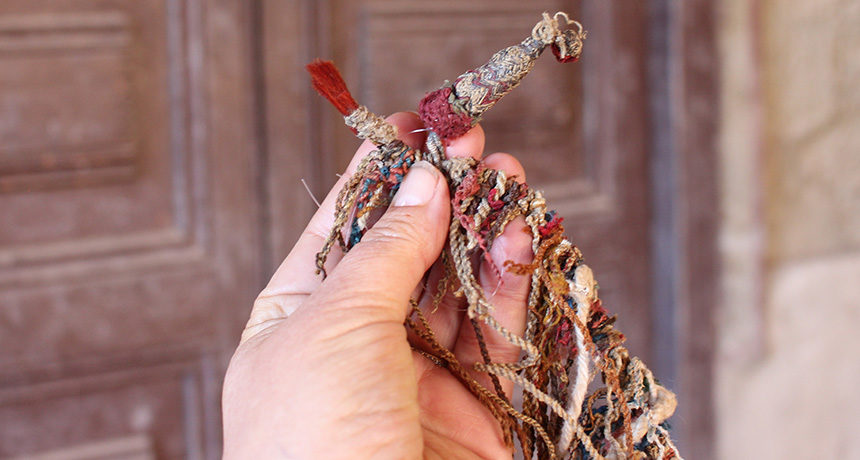
Researchers have long wondered whether some twisted and knotted cords from the Inca Empire, which ran from 1400 to 1532, represent a kind of writing about events and people. Many scholars suspect that these textile artifacts, known as khipus, mainly recorded decimal numbers in an accounting system. Yet Spanish colonial documents say that some Inca khipus contained messages that runners carried to various destinations.
Now a new twist in this knotty mystery comes from two late 18th century khipus stored in a wooden box at San Juan de Collata, a Peruvian village located high in the Andes Mountains. A total of 95 cord combinations of different colors, animal fibers and ply directions, identified among hundreds of hanging cords on these khipus, signify specific syllables, reports Sabine Hyland. Hyland, a social anthropologist at the University of St. Andrews in Scotland, describes the khipus online April 19 in Current Anthropology.
Her findings support a story told by Collata villagers that the khipus are sacred writings of two local chiefs concerning a late 18th century rebellion against Spanish authorities.
The Collata khipus display intriguing similarities to Inca khipus, including hanging cords with nearly the same proportions of two basic ply directions, Hyland says. A better understanding of Central Andean khipus from the 1700s through the 1900s will permit a reevaluation of the earlier Inca twisted cords, she suggests.
Each Collata khipu, like surviving Inca examples, consists of a horizontal cord from which a series of cords hang. One Collata specimen contains 288 hanging cords separated into nine groups by cloth ribbons tied at intervals along the top cord. The other khipu features 199 hanging cords divided by ribbons into four groups. Knots appear only at cord ends to prevent unraveling. In contrast, proposed accounting khipus contain many knots denoting numbers.
Collata khipus' initial hanging cords are made of bundles of colored animal hairs that represent the message's subject matter, Hyland proposes. One khipu starts with a tuft of bright red deer hair, followed by a woven, cone-shaped bundle with metallic-colored thread. The second khipu commences with a woven, tube-shaped bundle of multicolored alpaca hair atop the remains of a red tassel.
"The Collata khipus are completely unlike accounting khipus that I have been studying for over a decade," Hyland says. Central Andean khipus generally viewed as accounting devices were often made of cotton, and they contain two main colors, between 15 and 39 cord combinations and repetitive knot sequences.
Hyland makes an "excellent case" that these cords represent syllables and probably words as well, says anthropological archaeologist Penelope Dransart of the University of Wales Trinity Saint David in Lampeter.
So far, Hyland has translated the final three cords on one khipu as the word Alluka, the name of a family lineage in Collata. She first talked to villagers and identified the lineage chief that they claimed wrote one of the khipus. Hyland then assigned the three syllables in Alluka to the trio of ending cords, assuming that the sender's name would appear either there or at the beginning of the message. That enabled her to decipher the final cords on the second khipu as Yakapar, the name of a family lineage in a neighboring village. Heads of these lineages wrote the corded messages, Hyland suspects.
She has not yet deciphered other cords on the two khipus.
Hyland's insights into 18th century khipus are "profoundly significant," but won't help to decipher Inca twisted and knotted cords, predicts Harvard University archaeologist Gary Urton. Collata villagers probably invented a phonetic form of khipu communication after the Inca civilization's demise, when they were exposed to Spaniards' alphabetic writing, Urton says. Inca khipus show no signs of cord combinations that corresponded to particular speech sounds, he asserts.
Thanks to the new discoveries, though, "we have hope that at least some khipus might be understood," says archaeologist Jeffrey Splitstoser of George Washington University in Washington, D.C. Before Hyland's report, Splitstoser thought it likely that colored threads on khipus had arbitrary meanings assigned by their makers, making them indecipherable. He studies khipus from the Wari empire, which flourished in the Peruvian Andes from around 600 to 1000 (SN: 5/10/03, p. 302).
Officials at several museums with khipu collections have classified as forgeries a few animal-hair specimens that resemble the Collata khipus, Hyland says. Those alleged fakes deserve a closer look for signs of writing, she contends.



Comment: See also: High in the Andes, Keeping an Incan Mystery Alive